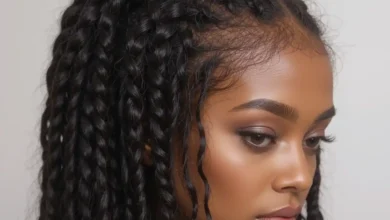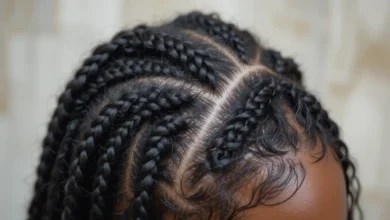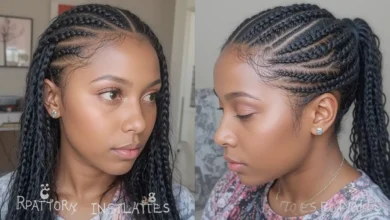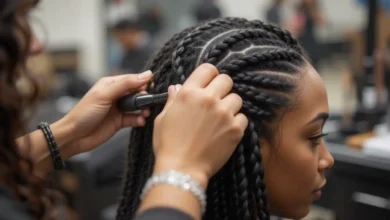Box Braids vs Knotless Braids: A Comprehensive Comparison
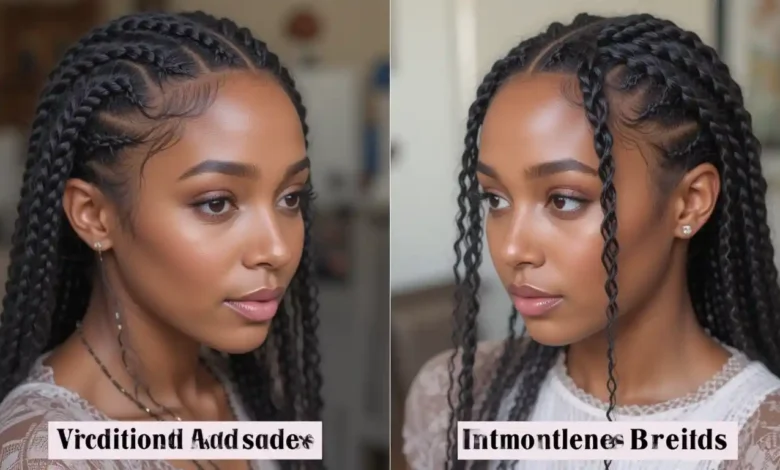
When it comes to choosing a braiding style, box braids and knotless braids are two popular options that often come up. Both styles offer a way to protect your natural hair while adding length and versatility. However, they differ significantly in terms of installation, comfort, and maintenance. In this comprehensive guide, we will explore the key differences between box braids and knotless braids to help you make an informed decision about which style is right for you.
1. What Are Box Braids?
Box braids are a traditional and classic braiding style that involves dividing the hair into small sections, which are then braided from the root to the tip. This style is characterized by its boxy sections, hence the name “box braids.” The braids can be created using natural hair or with the addition of synthetic hair for extra length and volume.
Installation of Box Braids
Installing box braids requires dividing the hair into small square sections. Each section is then braided with synthetic or natural hair extensions. This technique creates a distinctive boxy appearance that is both stylish and protective for the natural hair underneath.
Pros and Cons of Box Braids
Pros:
- Versatility: Box braids can be styled in various ways, from buns to ponytails.
- Durability: They tend to last longer than other braiding styles, making them a cost-effective choice.
Cons:
- Installation Time: Box braids can take several hours to install, depending on the length and size.
- Scalp Tension: The tight braiding can cause discomfort and tension on the scalp, especially if the braids are too tight.
2. What Are Knotless Braids?
Knotless braids are a newer braiding technique that avoids the use of knots at the root of the braid. Instead, the braiding process starts with a natural hair section and gradually incorporates hair extensions as the braid progresses. This method creates a more seamless and natural look.
Installation of Knotless Braids
The installation of knotless braids involves parting the hair into sections and braiding without creating a knot at the root. This technique helps to prevent tension on the scalp and provides a smoother transition between natural hair and extensions.
Pros and Cons of Knotless Braids
Pros:
- Less Tension: Knotless braids reduce tension on the scalp, leading to increased comfort.
- Natural Look: They provide a more natural appearance with less visible knots.
Cons:
- Shorter Duration: Knotless braids may not last as long as box braids and may need more frequent maintenance.
- Skill Level: The technique requires a higher skill level and may take longer to master.
3. Comparing Installation Techniques
When comparing box braids vs knotless braids, the installation techniques are a major factor to consider. Box braids involve creating knots at the base of each braid, which can lead to a more defined but potentially tight look. In contrast, knotless braids avoid this knot, resulting in a smoother and less bulky appearance.
Box Braids Installation
- Preparation: Hair is sectioned into small, square parts.
- Braiding: Each section is braided from the root, creating visible knots.
Knotless Braids Installation
- Preparation: Hair is parted into sections.
- Braiding: Braids start with the natural hair and gradually include extensions, avoiding knots.
4. Comfort and Scalps Tension
One of the most significant differences between box braids and knotless braids is the level of comfort they provide. Box braids can sometimes cause tension and discomfort due to the knots at the roots. Knotless braids, on the other hand, are designed to reduce this tension, offering a more comfortable experience.
Box Braids Comfort
- Scalp Tension: The knots at the root can cause tightness and discomfort.
- Adaptation Period: It may take time for the scalp to adjust to the tightness.
Knotless Braids Comfort
- Reduced Tension: The lack of knots minimizes scalp tension.
- Immediate Comfort: Generally, they are more comfortable from the start.
5. Maintenance and Longevity
Both box braids and knotless braids require regular maintenance to keep them looking their best. However, their maintenance routines differ due to their installation techniques.
Box Braids Maintenance
- Washing: Box braids can be washed, but care must be taken to avoid frizzing the braids.
- Moisturizing: Regular moisturizing of the scalp and braids is essential to prevent dryness.
Knotless Braids Maintenance
- Washing: Knotless braids can be washed more easily without affecting the braid’s appearance.
- Moisturizing: Similar to box braids, keeping the scalp moisturized is important.
6. Versatility in Styling
Both styles offer versatility, but the ease of styling can vary. Box braids provide a structured look that allows for a range of hairstyles, while knotless braids offer a more flexible and natural appearance.
Box Braids Styling
- Updos: Box braids can be styled into various updos and ponytails.
- Buns and Twists: They can be easily twisted or styled into buns.
Knotless Braids Styling
- Natural Movement: The lack of knots allows for more natural movement.
- Flexibility: They can be styled into various looks with less bulk.
7. Choosing the Right Style for Your Hair Type
When deciding between box braids and knotless braids, it’s important to consider your hair type and desired look. Box braids might be better for those who prefer a more defined and longer-lasting style, while knotless braids might suit those looking for a more natural appearance and reduced scalp tension.
Box Braids for Different Hair Types
- Thicker Hair: Box braids can add volume and definition.
- Curly Hair: Ideal for managing and protecting curly textures.
Knotless Braids for Different Hair Types
- Fine Hair: Knotless braids are less likely to cause breakage.
- Sensitive Scalps: They are gentler on the scalp.
8. Cost and Time Considerations
Both braiding styles involve costs and time commitments, which can vary depending on the salon and the complexity of the braids.
Box Braids Cost and Time
- Installation Time: Typically longer due to the knotting technique.
- Cost: Generally higher due to the time and skill required.
Knotless Braids Cost and Time
- Installation Time: May be shorter as there are no knots to create.
- Cost: Can vary but may be slightly less expensive than box braids.
9. Impact on Hair Health
The impact on hair health is a crucial factor when choosing between box braids and knotless braids. Both styles offer protection, but their effects on hair health can differ.
Box Braids and Hair Health
- Protection: Provides a protective style that can help with growth.
- Potential Damage: The tightness can cause breakage if not done properly.
Knotless Braids and Hair Health
- Protection: Offers protection without excessive tension.
- Gentler: Generally considered gentler on the scalp and hair.
10. Final Thoughts
Choosing between box braids and knotless braids ultimately depends on your preferences and needs. Both styles offer unique benefits, and understanding these can help you make the best choice for your hair. Whether you prioritize longevity and structure or comfort and a natural look, both box braids and knotless braids can be excellent options for achieving beautiful and versatile hairstyles.
FAQ
- Which is better for a sensitive scalp: box braids or knotless braids?
- Knotless braids are generally better for sensitive scalps due to their reduced tension and lack of knots.
- How long do box braids typically last compared to knotless braids?
- Box braids tend to last longer than knotless braids, usually up to 8-12 weeks, while knotless braids might last around 6-8 weeks.
- Can you wash your hair with box braids in?
- Yes, you can wash box braids, but it’s important to do so carefully to avoid frizzing.
- Are knotless braids more expensive than box braids?
- Knotless braids may be slightly less expensive than box braids due to the quicker installation time, but prices can vary.
- Can box braids cause damage to your natural hair?
- Box braids can cause damage if installed too tightly or if left in for too long, potentially leading to breakage.

